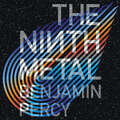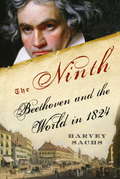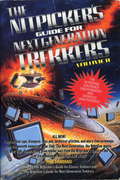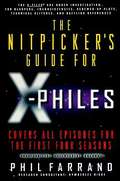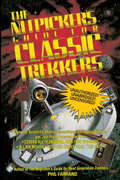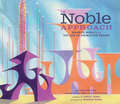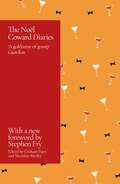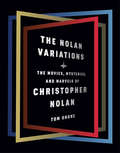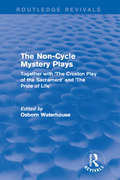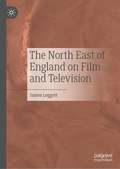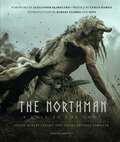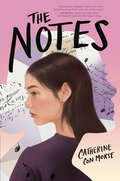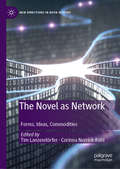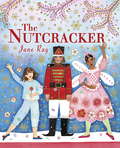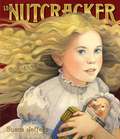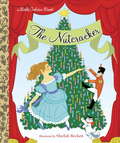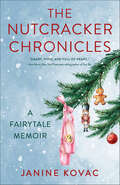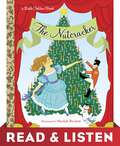- Table View
- List View
The Nine Old Men: Lessons, Techniques, And Inspiration From Disney's Great Animators
by Andreas DejaLearn from the men who changed animation forever <p><P>Walt Disney’s team of core animators, who he affectionately called his "Nine Old Men," were known for creating Disney’s most famous works, as well as refining the 12 basic principles of animation. Follow master animator and Disney legend Andreas Deja as he takes you through the minds and works of these notable animators. An apprentice to the Nine Old Men himself, Deja gives special attention to each animator and provides a thoughtful analysis on their techniques that include figure drawing, acting, story structure, and execution. The in-depth analysis of each animator’s work will allow you to refine your approach to character animation. Rare sequential drawings from the Disney archives also give you unprecedented access and insight into the most creative minds that changed the course of animation. <li>Instruction and analysis on the works of each of the Nine Old Men broaden your creative choices and approaches to character animation <li>Original drawings, some never-before-seen by the public are explored in depth, giving you behind-the-scenes access into Disney animation history <li>Gain first-hand insight into the foundation of timeless characters and scenes from some of Disney’s most memorable feature and short films
The Ninth Metal: The Comet Cycle Book 1 (The Comet Cycle #1)
by Benjamin PercyFrom award-winning author Benjamin Percy comes an explosive, breakout speculative thriller in which a powerful new metal arrives on Earth in the wake of a meteor shower, triggering a massive new 'gold rush' in the Midwest and turning life as we know it on its head. The first of a cycle of novels set in a shared universe. It might have been the end of days. Instead it was the beginning of something shockingly new. They called the comet Cain, after the astronomer who discovered it. It passed 500,000 miles from Earth. We were spared planetary destruction and granted a light show like no other. But, one year later, Earth span into the debris field left by the comet and a meteor storm struck. Roads, buildings and even a small town were annihilated.The meteors impacted heavily around the dying mining town of Northfall, Minnesota. It was the night of a mysterious double murder, the deed overshadowed by the discovery that the burning remains of the rock contained an unknown substance more precious than gold: the Ninth Metal. And with that discovery, everything changed.Benjamin Percy is an award-winning novelist, celebrated comic books writer and author of the Wolverine podcast. The Ninth Metal is the first of a cycle of novels set in a shared universe. (P) 2021 Houghton Mifflin Harcourt
The Ninth: Beethoven and the World in 1824
by Harvey Sachs"All men become brothers . . . Be embraced, ye millions!" The Ninth Symphony, a symbol of freedom and joy, was Beethoven's mightiest attempt to help humanity find its way from darkness to light, from chaos to peace. Yet the work was born in a repressive era, with terrified Bourbons, Hapsburgs, and Romanovs using every means at their disposal to squelch populist rumblings in the wake of the French Revolution and Napoleon's wars. Ironically, the premiere of this hymn to universal brotherhood took place in Vienna, the capital of a nation that Metternich was turning into the first modern police state.The Ninth's unveiling, on May 7, 1824, was the most significant artistic event of the year, and the work remains one of the most precedent-shattering and influential compositions in the history of music--a reference point and inspiration that resonates even today. But in The Ninth, eminent music historian Harvey Sachs demonstrates that Beethoven was not alone in his discontent with the state of the world. Lord Byron died in 1824 during an attempt to free Greece from the domination of the Ottoman empire; Delacroix painted a masterpiece in support of that same cause; Pushkin, suffering at the hands of an autocratic czar, began to draft his anti-authoritarian play Boris Godunov; and Stendhal and Heine wrote works that mocked conventional ways of thinking.The Ninth Symphony was so unorthodox that it amazed and confused listeners at its premiere--described by Sachs in vibrant detail--yet it became a standard for subsequent generations of creative artists, and its composer came to embody the Romantic cult of genius. In this unconventional, provocative new book, Beethoven's masterwork becomes a prism through which we may view the politics, aesthetics, and overall climate of the era.Part biography, part history, part memoir, The Ninth brilliantly explores the intricacies of Beethoven's last symphony--how it brought forth the power of the individual while celebrating the collective spirit of humanity. From the Hardcover edition.
The Nitpicker's Guide for Next Generation Trekkers Volume 2
by Phil FarrandA follow-up to the first, best-selling Nitpicker's guide ferrets out the plot inconsistencies, scientific inaccuracies, and other foul-ups in the seventh, final season of the TV series, Star Trek: The Next Generation.
The Nitpicker's Guide for X-Philes
by Phil FarrandThe truth is, the nits are out there. . . . What's weird about Samantha T. Mulder's birthday? (She has two of them: January 22 and November 21. ) What's amazing about Mulder's cell phone? (It operates inside a metal boxcar, buried in a canyon, out in the deserts of New Mexico: anywhere!) Scully and Mulder, you have reason to be paranoid. Armed with keen detective sense, attention to detail, and a VCR, author Phil Farrand has done some forensic work of his ownííand dissected every technical foul-up, plot oversight, and alien intrusion on theX-Files(r). Paranormal he's not, but he'd like to know why T. A. Berube has a six-digit zip code or how the VCRs at the 2400 Court motel in Braddock Heights, Maryland, can play a tape after it's been ejected. Nitpicking? You bet. So join his conspiracy to have hours of mental stimulation and fun with: Equipment flubs Changed premises Plot oversights Fun facts Trivia questions Reviews of every show for all four seasons And more
The Nitpicker’s Guide for Classic Trekkers
by Phil FarrandSix feature films, the wildly successful television spin-off Star Trek: The Next Generation, endless reruns, videotapes, conventions, a line of best-selling novels, and William Shatner's New York Times best-seller Star Trek Memories have kept the Star Trek spirit alive and well, even 25 years after its cancellation. Now this must-have book for all Trekkers -- which covers every episode of the original series, the pilot, and all six movies -- reveals all the bloopers, continuity errors, plot oversights, equipment malfunctions, and goof-ups that discerning, die-hard fans love to spot, but may have missed. Written especially for all those who find themselves thinking, "Hey, if the transporter is broken, why don't they just use a shuttlecraft?", this nitpicky volume includes Kirk's toupee watch; an examination of the logic of the miniskirted female crew members; number of times Kirk violated the Prime Detective and lots of trivia questions, fun facts, quizzes, and more. Live long and nitpick.
The Noble Approach: Maurice Noble and the Zen of Animation Design
by Tod PolsonThis extraordinary volume examines the life and animation philosophy of Maurice Noble, the noted American animation background artist and layout designer whose contributions to the industry span more than 60 years and include such cartoon classics as Duck Dodgers in the 24 ½th Century, What's Opera, Doc?, and The Road Runner Show. Revered throughout the animation world, his work serves as a foundation and reference point for the current generation of animators, story artists, and designers. Written by Noble's longtime friend and colleague Tod Polson and based on the draft manuscript Noble worked on in the years before his death, this illuminating book passes on his approach to animation design from concept to final frame, illustrated with sketches and stunning original artwork spanning the full breadth of his career.
The Noel Coward Diaries: With a Foreword by Stephen Fry
by Sheridan Morley Graham Payn'A gold mine of gossip with a cast of thousands' GUARDIANThe unexpurgated diaries of one of the greatest, most talented, and wittily flamboyant characters of the 20th century - with a new introduction by Stephen Fry'Compulsive reading' SUNDAY TIMES'19th February 1956. A A Milne has died. Lord Beaverbrook has not ... Larry is going to make a movie of The Sleeping Prince with Marilyn Monroe, which might conceivably drive him round the bend''28th February 1960 Princess Margaret has announced her engagement to Tony Armstrong-Jones ... He looks quite pretty, but whether or not the marriage is entirely suitable remains to be seen.'Noel Coward was a renowned actor, dramatist, director - and star. His incredible zest, versatility and unrivalled wit are revealed in these diaries, with a cast of characters ranging from The Beatles to the Queen, Churchill to Marilyn Monroe.Touching, funny and revealing, THE NOEL COWARD DIARIES is a superb account of one of the greatest entertainers of all time.
The Noel Coward Diaries: With a Foreword by Stephen Fry
by Sheridan Morley Graham Payn'A gold mine of gossip with a cast of thousands' GUARDIANThe unexpurgated diaries of one of the greatest, most talented, and wittily flamboyant characters of the 20th century - with a new introduction by Stephen Fry'Compulsive reading' SUNDAY TIMES'19th February 1956. A A Milne has died. Lord Beaverbrook has not ... Larry is going to make a movie of The Sleeping Prince with Marilyn Monroe, which might conceivably drive him round the bend''28th February 1960 Princess Margaret has announced her engagement to Tony Armstrong-Jones ... He looks quite pretty, but whether or not the marriage is entirely suitable remains to be seen.'Noel Coward was a renowned actor, dramatist, director - and star. His incredible zest, versatility and unrivalled wit are revealed in these diaries, with a cast of characters ranging from The Beatles to the Queen, Churchill to Marilyn Monroe.Touching, funny and revealing, THE NOEL COWARD DIARIES is a superb account of one of the greatest entertainers of all time.
The Nolan Variations: The Movies, Mysteries, and Marvels of Christopher Nolan
by Tom ShoneAn in-depth look at, and written in collaboration with, the man considered to be the most profound, and commercially successful director at work today--his work, including his latest blockbuster, the action-thriller/spy-fi Tenet ("Big, brashly beautiful, grandiosely enjoyable"--Variety); his influences, his vision, his enigmatic childhood past, and much more. With Nolan's never-before-seen photographs, storyboards, and scene sketches. "The Nolan Variations is that rare thing, a superb book about a living filmmaker. Erudite, complex, labyrinthine and mind-expanding--it's as close as you're ever going to get to the Escher drawing that is Christopher Nolan's remarkable brain."--Sam Mendes"Fabulous: intelligent, illuminating, rigorous, and highly readable. The very model of what a filmmaking study should be. Essential reading for anyone who cares about Nolan or about film for that matter."--Neal Gabler, author of An Empire of Their Own: How the Jews Invented Hollywood and Walt Disney, The BiographyA rare, intimate portrait of Christopher Nolan with the full cooperation of Nolan himself who opened up more fully than ever before in his talks with Tom Shone. In chapters structured by themes and motifs ("Time"; "Chaos"), Shone writes of Nolan's thoughts on movies, on plots; on time, identity, perception, chaos, daydreams.Here is Nolan on the evolution of his pictures, and the writers, artists, directors, and thinkers who have inspired and informed his films.To write the book, Tom Shone, who has known Nolan for more than two decades and who spent months with the director, was given unprecedented access to Nolan's notes, scripts, storyboards, and artwork.In this riveting portrait of an artist, Shone deftly navigates Nolan's themes, influences, and working methods (both in writing and directing). Here is his trans-Atlantic childhood ("It makes you feel very differently about the concept of 'home'") . . . how he dreamed up the plot of Inception lying awake one night in his dorm ("I prized the imaginative space of listening to music in the dark, thinking about things, imagining things, films, stories") . . . his color-blindness and its effect on Memento ("People are fascinated by other people's perception of the world and the way in which it differs") . . . his obsession with puzzles and optical illusions . . . and much, much more.
The Non-Cycle Mystery Plays: Together with 'The Croxton Play of the Sacrament' and 'The Pride of Life' (Routledge Revivals)
by Osborn WaterhouseBetween the beginning of the tenth and the end of the sixteenth centuries, in all parts of Great Britain from Aberdeen to Cornwall, performances of liturgical and mystery plays are on record. This book, first published in 1909, is a collection of early-English religious plays with a detailed introduction written by the editor Osborn Waterhouse. The Non-Cycle Mystery Plays will be of interest to students of drama, performance and theatre studies.
The Non-User-Friendly Guide For Aspiring TV Writers: Experience and Advice From the Trenches (Million Dollar Writing Series) (Million Dollar Writing Series)
by Steven L. SearsA veteran writer presents his personal account of being in the trenches of the television industry, offering advice and tactics for aspiring scriptwriters. Steven L. Sears has had a successful career in film and television encompassing over thirty years of involvement at all levels. From his beginnings as a staff writer on the hit NBC show The A-Team, to Co-Executive Producer on the hit series Xena-Warrior Princess for MCA/Universal, creator and Executive Producer of Sheena for Sony/TriStar Television, and many pilot and development deals with the major studios and production companies, he has amassed a huge amount of experience and knowledge about the inner workings of the entertainment industry. In The Non-User-Friendly Guide for Aspiring Television Writers, he shares that experience and gives advice for those considering a career in television writing. Instead of the traditional academic and sterile approach, Steven answers questions from a personal, first person perspective. The questions have been culled from the real world, people seeking out his advice and looking for the experience that most books don&’t have. Some of what he writes about are hard and difficult facts to accept about the business. Other times it&’s his opinion based on his vast experience. But all of it is unsweetened and direct. Even if you don&’t like his answers, he will certainly make you think hard about your approach and choices when pursuing a career in an extremely difficult industry. As a result, you will be better prepared to achieve the success that he has had. Accessible, personable, and relaxed, &“It&’s like having lunch with Steven and asking him questions about the business. Without having to watch him eat.&”
The North Beach Diet: Add Belly and Hip Fat Instantly with Batter Fried Twinkies and More
by Robert Kim BaileyStop dieting & start living. Make up the rules as you go! "I gained 145 pounds in just six months, became emotionally insulated, and allowed food to control every aspect of my life . . . now you can too." ?The North Beach Diet author Kim BaileyTestimonials:"I've been on just about every diet there is, Atkins, Weight Watchers, Jenny Craig, Dr. Phil, Richard Simmons, No Fat, All Fat, No Carbs, All Carbs, you name it, I've tried it . . . nothing worked . . . I kept losing weight. Finally! The North Beach Diet! I increased 2 dress sizes in just 10 days. Thank you! Thank you! Thank you! ?Susan Merrill"Krispy Kreme Donuts, Caramel Popcorn, Sara Lee Pound Cake with Ben & Jerry's Triple Chocolate Cookie Crunch . . . it was darn tough for us to make up our minds which of these favorites to consume while watching late night TV. The North Beach Diet showed us how we could get them all in by simple planning." ?Bill and Susan Kynes, personal fitness trainers.
The North East of England on Film and Television
by James LeggottThis book analyses the representation of North-East England in film and television. It is a response to the way a number of important British films and programmes—for example, Get Carter (1971), Whatever Happened to the Likely Lads (1973-74), Our Friends in the North (1996) and Billy Elliot (2000)—have used this particular setting to explore questions of class, identity and history. It argues for the significance and coherence of a North-East corpus of film and television through a series of case studies relating to specific eras or types of representation. These include regional writers working for television in the 1970s, the achievements of the workshop movement in the 1980s and works produced within the genres of documentary, crime drama, comedy, period drama and reality television. The book discusses how the communities and landscapes of the region have been used to explore processes of cultural change, and legacies of de-industrialisation.
The Northman: A Call to the Gods
by Robert EggersThe Northman: A Call to the Gods is the official look at how this epic Viking revenge thriller was conceived, written, cast, and produced by acclaimed director Robert Eggers. Set against the ruthless backdrop of tenth-century Norse territory, The Northman is the a new epic Viking revenge thriller by acclaimed director Robert Eggers (The Witch [2015] and The Lighthouse [2019]), featuring an all-star cast including Alexander Skarsgård, Nicole Kidman, Ethan Hawke, Anya Taylor-Joy, Willem Dafoe, and Björk. Compiled from fascinating interviews with the cast and crew, inspiring storyboards, exclusive behind-the-scenes photographs—including the director&’s own firsthand account of his creative processes in writing and directing—The Northman: A Call to the Gods explores the cold and forbidding world of the Vikings, their customs, traditions, and relentless thirst for battle and vengeance that inspired Eggers to write this compelling Norse saga. Learn how the wardrobe department recreated the intricate chain mail armor and costumes of Viking berserkers and warriors; delve into the research behind the art department&’s visual inspiration for replicating the villages of Hrafnsey and Freysdalur; and get the inside scoop on the challenges the cast encountered when creating the iconic characters of Amleth, Olga, Queen Gurdrún, and the Seeress. The Northman: A Call to the Gods is the perfect companion for both film fans and anyone interested in Viking history and legends. PROFILE OF AN AWARD-WINNING DIRECTOR: Using acclaimed director Robert Eggers&’ own firsthand account, The Northman: A Call to the Gods delivers a revealing profile of his inspirations, and his creative process. EXCLUSIVE PHOTOGRAPHS: Explore dozens of photographs of the set, crew, director Robert Eggers, and the award-winning cast, including Alexander Skarsgård, Nicole Kidman, Ethan Hawke, Anya Taylor-Joy, Willem Dafoe, and Björk. GO BEHIND THE SCENES: Delve into never-before-seen storyboards and set designs that give a glimpse into the fascinating art and craft of filmmaking. PERFECT FOR FILM ENTHUSIASTS: The Northman: A Call to the Gods is the perfect gift for movie fans and anyone interested in Viking legend and lore.
The Nostalgia Entertainment Sourcebook: The Complete Resource Guide to Classic Movies, Vintage Music, Old Time Radio and Theatre
by Randy Skretvedt Jordan R. YoungA resource guide for finding the sounds and accoutrements that accompany the entertainment of the 1920s, 1930s, and 1940s. Fan clubs, festivals, museums, stores, societies and many other resources. No hobbyist should be without this book!
The Notes
by Catherine Con MorseA reserved Chinese American teen at a Southern performing arts boarding school comes into her own under the tutelage of a glamorous new piano teacher. A moving coming-of-age-novel from a debut novelist about first love, adolescent angst, and academic pressures.&“Compellingly readable. Make room in the boarding-school book canon for a new classic.&” - Jeff Zentner, award-winning author of In the Wild Light and The Serpent King"A moving, highly virtuosic, and heart-rending portrait of an aspiring teen pianist trying to find her way...it made me feel seen." - Patricia Park, author of Imposter Syndrome and Other Confession of Alejandra Kim and What&’s Eating Jackie Oh?Claire Wu isn&’t sure that she has what it takes to become a successful concert pianist. It&’s the fear of every student at Greenwood School for the Performing Arts: becoming a washed-out performer who couldn't make it big. And Claire's no Rocky Wong, the ace pianist at their boarding school.Then Dr. Li shows up. She&’s like no other teacher at Greenwood: mysterious, sophisticated, fascinating. Under Dr. Li&’s tutelage, Claire works harder and dreams bigger than ever. And her crush Rocky finally seems interested. Maybe she&’ll even be "Chinese enough" to join the elusive Asian Student Society.Everything is falling into place until eerily personal notes about Claire&’s bond with Dr. Li appear. Claire starts to feel the pressure. But she isn't the only one. Everyone is feeling the strain. Especially Rocky, whose extreme perfectionism hides something more troubling.As the Showcase tension crescendos, Claire must decide if she&’s ready to sink or swim. Only then can she discover who she really is and learn if she&’s ready to give her all for a shot at greatness.The Notes is a powerful and poignant debut YA novel from award-winning writer Catherine Con Morse about dealing with academic pressures, falling in love for the first time, and finding yourself.
The Notorious Pagan Jones
by Nina BerryPagan Jones went from America's sweetheart to fallen angel in one fateful night in 1960: the night a car accident killed her whole family. Pagan was behind the wheel and driving drunk. Nine months later, she's stuck in the Lighthouse Reformatory for Wayward Girls and tortured by her guilt-not to mention the sadistic Miss Edwards, who takes special delight in humiliating the once-great Pagan Jones. But all of that is about to change. Pagan's old agent shows up with a mysterious studio executive, Devin Black, and an offer. Pagan will be released from juvenile detention if she accepts a juicy role in a comedy directed by award-winning director Bennie Wexler. The shoot starts in West Berlin in just three days. If Pagan's going to do it, she has to decide fast-and she has to agree to a court-appointed "guardian," the handsome yet infuriating Devin, who's too young, too smooth and too sophisticated to be some studio flack. The offer's too good to be true, Berlin's in turmoil and Devin Black knows way too much about her-there's definitely something fishy going on. But if anyone can take on a divided city, a scheming guardian and the criticism of a world that once adored her, it's the notorious Pagan Jones. What could go wrong?rdian," the handsome yet infuriating Devin, who's too young, too smooth, too sophisticated to be some studio flack. The offer's too good to be true, Berlin's in turmoil and Devin Black knows way too much about her-there's definitely something fishy going on. But if anyone can take on a divided city, a scheming guardian and the criticism of a world that once adored her, it's the notorious Pagan Jones. What could go wrong?
The Novel as Network: Forms, Ideas, Commodities (New Directions in Book History)
by Corinna Norrick-Rühl Tim LanzendörferThe Novel as Network: Forms, Ideas, Commodities engages with the contemporary Anglophone novel and its derivatives and by-products such as graphic novels, comics, podcasts, and Quality TV. This collection investigates the meaning of the novel in the larger system of contemporary media production and (post-)print culture, viewing the novel through the lens of actor network theory as a node in the novel network. Chapters underscore the deep interconnection between all the aspects of the novel, between the novel as a (literary) form, as an idea, and as a commodity. Bringing together experts from American, British, and Postcolonial Studies, as well as Book, Publishing, and Media Studies, this collection offers a new vantage point to view the novel in its multifacetious expressions today.
The Nutcracker
by Jane RayThe ultimate children's gift edition of the beloved classic ballet story, The Nutcracker.Christmas Eve is the most magical night of the year, when the house is scented with wood smoke and spices, and there are secrets under every bed . . . When the clock strikes midnight, Clara's new nutcracker doll comes to life and leads her on a thrilling adventure, battling with the wicked Mouse King and his troops, then journeying to the Kingdom of Sweets. Retold simply and lyrically, with enchanting illustrations that capture all the joy and excitement of Christmas, this beautiful book from award-winning book-maker Jane Ray, this is the ultimate contemporary edition of everyone's favourite Christmas ballet story!
The Nutcracker
by Karen KainMisha and Marie are thrilled that Christmas is coming. It’s a frosty night, the neighbors are all invited, and Peter the stable boy is sweeping the barn in preparation for the dancing to come. But there’s a disappointment in store. Instead of the beautiful doll she’d hoped for, the only thing strange old Uncle Nikolai has for Marie is a wooden nutcracker. Marie thinks it’s a wonderful gift. Little does she know that it will lead her and her brother on the adventure of a lifetime.When Misha and Marie finally go to bed on Christmas Eve, they sleep fitfully and are beset by nightmares. In one particularly bad dream, they join forces — unusual for the squabbling children — and conquer an army that might harm the nutcracker. Their reward is splendid: they are swept to the realm of the Snow Queen for a night of wonders.James Kudelka, the Artistic Director of the National Ballet of Canada, is one of North America’s foremost dance artists. His vision of The Nutcracker is elegantly told by Karen Kain and beautifully rendered by artist Rajka Kupesic, herself a ballet dancer.
The Nutcracker
by Susan JeffersNew York Times bestselling artist and Caldecott Honor winner Susan Jeffers has created a Nutcracker as only she can—with lavish illustrations, magnificent detail, and enchanting holiday scenes on every page. This is The Nutcracker as you’ve never seen it before!Join Marie, Fritz, and the intriguing Nutcracker himself on a magical Christmas Eve adventure. Behold the frightful Mouse King, the elegant Sugar Plum fairies, and the entire Land of Sweets in this dazzling, gorgeously illustrated holiday classic. With spare text based on the story in the ballet, this book offers a front-row seat to the enthralling tale that is a perennial favorite of adults and children alike. And for Susan Jeffers fans looking for extra content, an author’s note is included at the end of the book, in which she explains what inspired her to turn this holiday tradition into a show-stopping picture book.
The Nutcracker (Little Golden Book)
by Sheilah Beckett Rita BalducciA Christmas classic returns to Little Golden Books, with beautiful new artwork by a beloved Golden Books illustrator! The Nutcracker is back in print as a Little Golden Book, with all-new illustrations by Sheilah Beckett, who started illustrating Golden Books in the 1950s. This lovely retelling of the famous ballet will be a perfect holiday gift for any child who loves the ballet, Christmas stories, and fairy tales!
The Nutcracker Chronicles: A Fairytale Memoir
by Janine KovacPerfect for The Nutcracker holiday market and fans of work/life balance books, this memoir of a ballet dancer–turned–literary curator shares the real-life journey of a dancer, wife, and mother.The Nutcracker Chronicles, a modern twist on the beloved holiday ballet, intertwines the story of Clara and her nutcracker prince with the true-life stories that unfold backstage. The curtain rises on Ballet El Paso’s production of The Nutcracker, where young Janine Kovac is cast as Fritz, the boy who breaks the nutcracker. Her director is Ingeborg Heuser, a German woman who once performed for Hitler and who peppers her teaching with insults like, “Why can’t you just dance like a pretty girl?” At least it’s better than “You look like a cow on ice skates,” which is what the other girls hear daily. Onstage, Janine wins the battle and embarks on a voyage through a snowy forest to the Land of the Sweets, where she serves as spectator to a beautiful dance. She also travels offstage, leaving El Paso to study at San Francisco Ballet before landing a job in Iceland and returning to California, where she rises through the ranks from soldier to snowflake to candy soloist. Eventually, however, she is relegated to watching other people dance—her husband, her children, her students—and her claim to the spotlight is replaced by the quest to find joy in her new roles.
The Nutcracker: Read & Listen Edition (Little Golden Book)
by Rita BalducciA Christmas classic returns to Little Golden Books, with beautiful new artwork by a beloved Golden Books illustrator! The Nutcracker is back in print as a Little Golden Book, with all-new illustrations by Sheilah Beckett, who started illustrating Golden Books in the 1950s. This lovely retelling of the famous ballet will be a perfect holiday gift for any child who loves the ballet, Christmas stories, and fairy tales!This Read & Listen edition contains audio narration.

